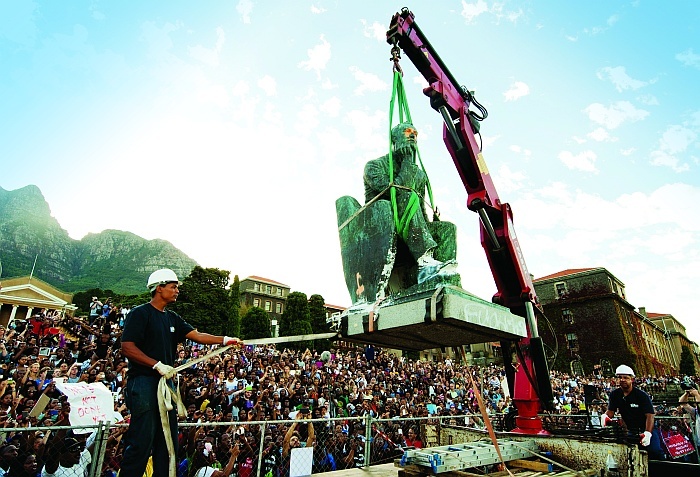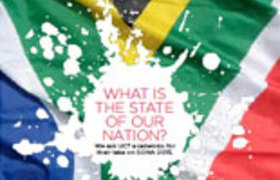Rhodes makes way for transformation
13 April 2015
Amid scenes of jubilation, the two–ton bronze casting of Cecil John Rhodes went quietly on 9 April, lifted by crane onto a flatbed truck and into temporary storage. Surrounded by euphoric students, the statue inched its way past the throng that had congregated to soak up the moment.
It will be held in storage until a decision is made by Heritage Western Cape about its ultimate fate.
This was a turning point for the university, 21 years into democracy and 186 years into its own history, said Vice–Chancellor Dr Max Price after a special Council meeting on 8 April voted to support the removal of the divisive statue.
The trial or dummy lift earlier on Thursday morning had gone smoothly, said Andre Theys, executive director of Properties & Services. The main challenge had been determining the fixings for the crane.
All that now remains is the plinth, leaving the question: what comes next?
That answer, says Price, concerns the future and how the university transforms itself into an inclusive and welcoming institution for its students, staff and alumni.
"It [Rhodes' statue] will be remembered for what comes in its place; probably not a statue but an acceleration, a renewed commitment to transformation to making the campus inclusive and to addressing the many issues which face not just the campus but the country and higher education."
Speaking to the media on 8 April after the Council meeting, chair of Council Archbishop Njongonkulu Ndungane said the university will now continue with the planned review of other symbols and names over the remainder of this year, aided by the energy generated during recent events: "The student engagement on this issue has added an energy and urgency to addressing many other aspects of transformation and has mobilised members of the university community not previously seized with the issue. The university management will partner with the students, different staff structures and the UCT community to review and refocus our transformation plans."
A silent witness to history
The Rhodes statue was a gift to UCT by the Rhodes Memorial Committee in 1934. It was commissioned in 1931 and created by sculptor Marion Walgate. It originally sat below the rugby fields, but in 1962 it was moved to a position above Madiba Circle, below the War Memorial, when the M3 was reconstructed and widened.
The statue has been a silent witness to decades of history at UCT, through the terms (or partial terms) of all five of its chancellors and eight of its nine vice–chancellors, and through moments of jubilation and shame. Those were reflected in the extinguishing of the Academic Torch of Freedom in 1957 and its relighting in 1994; in the triumphs of each of UCT's Nobel Laureates; in the [Archie] Mafeje Affair in 1968; the celebration of honorary graduate Nelson Mandela in 1990 and the country's first democratic elections in 1994.
Cause for celebration
But the month–long protests around the Rhodes statue provided other reasons for celebration, said Price after the Council meeting.
"We have students and a significant number of staff members who joined in with these protests, who aren't content with ready–made answers but want to head out in search of better questions and better answers.
"We've seen staff actively engaging with the public, through the media, with the students and with each other, what this current moment in history means for us, and how best to respond.
"We've had venues that have been packed with people who care about this campus community, who care about its future and their place in that future. They have disagreed vigorously; they have different views on how to get there but I think they share an ideal of a campus that is inclusive."
Life after the fall
On university life after Rhodes' fall, president of the Student Representative Council Ramabina Mahapa said: "This is not the end; on the contrary, we are just beginning to transform this university to the ideals it so much promotes. As the SRC, we encourage every student to participate and contribute to the social change that we are experiencing."
Mahapa said that the statue's removal would herald the immediate end of the students' occupation of 'Azania House' [Bremner Building], and that the SRC would now advocate for transformation from a "governance perspective", amid other student concerns.
Statues not the answer?
The idea of erecting statues rests uneasily with many of the UCT community. It's perhaps worth noting the plaque that was attached to the Rhodes statue, part of the university's Heritage Trail, which read:
"Rhodes' imperialist and racist attitude to Africa causes much controversy and resentment today, but without this section of the Groote Schuur estate which he donated for the founding of a university, UCT would probably not have come into existence in 1918. Rhodes envisioned Boer War enmity between English and Afrikaner being laid to rest by means of the interaction of promising young people from these backgrounds in an academic environment. Just as many young Afrikaners in the 1930s and 1940s were uncomfortable on a campus which provided daily reminders of Rhodes and Jameson, today many students question the ways in which these figures continue to be memorialised."
Concern was expressed from the beginning, said UCT's historian, Professor Howard Phillips in a Sunday Times interview.
The Rhodes Memorial Committee was a local body of Rhodes admirers, and when the offer of donation was made in 1931, Senate suggested that Council consider the advisability of erecting any statues on the campus.
It was speculated, said Philips, that "it was either because of how objectionable the statue might be to Afrikaners, who were a strong minority on the campus at the time, or because of 'an even wider idea that statues at some point – whoever they are of – would get you into trouble'".
It's only the beginning
"Do you know what Rhodes did to our people?" This exchange between students was overheard on the Jameson steps, as the crowd slowly filed away. The empty plinth is the beginning of a period of introspection for the university.
Story by Abigail Calata, Yusuf Omar and Helen Swingler. Photo by Roger Sedres.
 This work is licensed under a Creative Commons Attribution-NoDerivatives 4.0 International License.
This work is licensed under a Creative Commons Attribution-NoDerivatives 4.0 International License.
Please view the republishing articles page for more information.
Front page
Opinions
Photo Essay
Front page extra
Previous Editions










